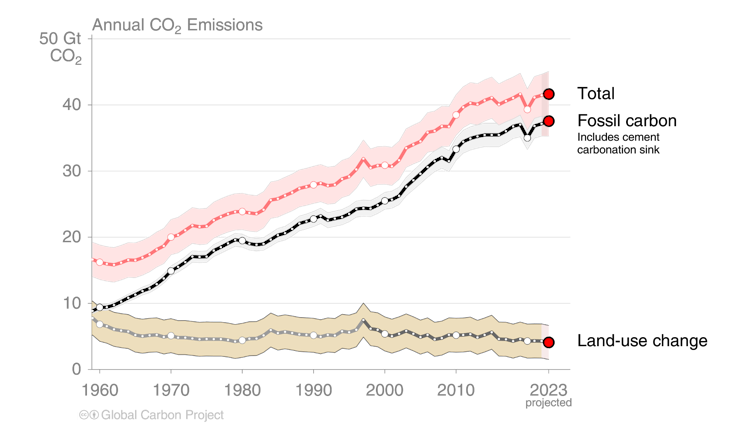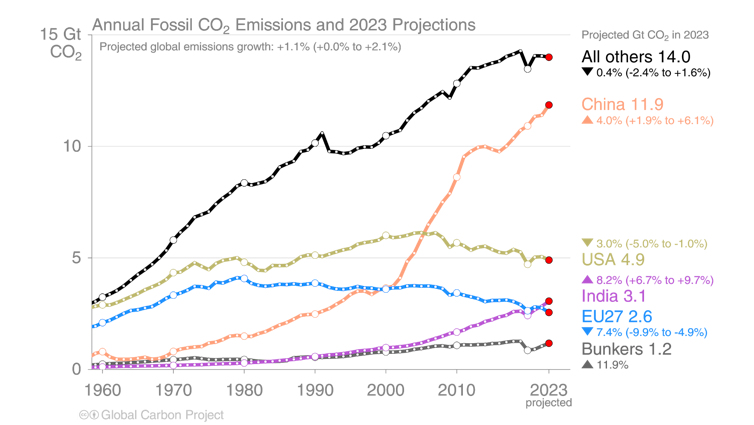Global emissions of fossil carbon dioxide (CO₂), in yet another year of growth, will increase by 1.1% in 2023. These emissions will hit a record 36.8 billion tonnes. That’s the finding of the Global Carbon Project’s 18th annual report card on the state of the global carbon budget, which we released today.
Fossil CO₂ includes emissions from the combustion and use of fossil fuels (coal, oil and gas) and cement production. Adding CO₂ emissions and removals from land-use change, such as deforestation and reforestation, human activities are projected to emit 40.9 billion tonnes of CO₂ in 2023.
The world’s vegetation and oceans continue to remove about half of all CO₂ emissions. The rest builds up in the atmosphere and is causing increasing warming of the planet.
At current emission levels, the remaining carbon budget for a one-in-two chance to limit warming to 1.5°C will likely be exceeded in seven years, and in 15 years for 1.7°C. The need to cut emissions has never been so urgent.
Emissions from every fossil source are up
Fossil CO₂ emissions now account for about 90% of all CO₂ emissions from human activities. Emissions from every single fossil source increased this year compared to 2022:
- coal (41% of global CO₂ emissions) up 1.1%
- oil (32%) up 1.5%
- natural gas (21%) up 0.5%
- cement (4%) up 0.8%.

Although global emissions have increased, the picture for individual countries is more diverse. There are some signs of progress towards decarbonisation.
China’s emissions (31% of the global total) increased by 4% with growth in all fossil fuel sources. The highest relative growth was from oil emissions. This was in part due to the transport sector’s recovery after COVID-19 pandemic shutdowns.
The United States’ emissions (14% of global) are down by 3%. The rapid retirement of coal-fired power plants drove most of this decline. US coal emissions are the lowest since 1903.
India’s emissions (8% of global) increased by 8.2%. Emissions for all fossil fuels grew by 5% or more, with coal the highest at 9.5%. India is now the world’s third-largest fossil CO₂ emitter.
European Union emissions (7% of global) are down by 7.4%. This decline was due to both high renewable energy penetration and the impacts on energy supply of the war in Ukraine.
During the decade of 2013-2022, 26 countries had declining fossil CO₂ emission trends while their economies continued to grow. The list includes Brazil, France, Germany, Italy, Japan, Portugal, Romania, South African, United Kingdom and USA.

Total CO₂ emissions are near a peak
While fossil CO₂ emissions continue to increase, net emissions from land-use change, such as deforestation (CO₂ source), minus CO₂ removals, such as reforestation (CO₂ sink), appear to be falling. However, estimates of emissions from land-use change are highly uncertain and less accurate overall than for fossil fuel emissions.
Our preliminary estimate shows net emissions from land-use change were 4.1 billion tonnes of CO₂ in 2023. These emissions follow a small but relatively uncertain decline over the past two decades.
The declining trend was due to decreasing deforestation and a small increase in reforestation. The highest emitters are Brazil, Indonesia and the Democratic Republic of the Congo. These three countries contribute 55% of net global CO₂ emissions from land-use change.
When we combine all CO₂ emissions from human activities (fossil and land use), we find very little trend in total emissions over the past decade. If confirmed, this would imply global CO₂ emissions from human activities are not growing further but remain at very high record levels.
Stable CO₂ emissions, at about 41 billion tonnes per year, will lead to continuing rapid CO₂ accumulation in the atmosphere and climate warming. To stabilise the climate, CO₂ emissions from human activities must reach net zero. This means any residual CO₂ emissions must be balanced by an equivalent CO₂ removal.
Nature’s a big help, with a little human help
Terrestrial vegetation and ocean absorb about half of all CO₂ emissions. This fraction has remained remarkably stable for six decades.
Besides the natural CO₂ sinks, humans are also removing CO₂ from the atmosphere through deliberate activities. We estimate permanent reforestation and afforestation over the past decade have removed about 1.9 billion tonnes of CO₂ per year.
This is equivalent to 5% of fossil fuel emissions per year.
Other non-vegetation strategies are in their infancy. They removed 0.01 million tonnes of CO₂.
Machines (direct air carbon capture and storage) pulled 0.007 million tonnes of CO₂ out of the atmosphere. Enhanced weathering projects, which accelerate natural weathering processes to increase the CO₂ uptake by spreading certain minerals, accounted for the other 0.004 million tonnes. This is more than a million times smaller than current fossil fuel emissions.
The remaining carbon budget
From January 2024, the remaining carbon budget for a one-in-two chance to limit global warming to 1.5°C has been reduced to 275 billion tonnes of CO₂. This budget will used up in seven years at 2023 emission levels.
The carbon budget for limiting warming to 1.7°C has been reduced to 625 billion tonnes of CO₂, with 15 years left at current emissions. The budget for staying below 2°C is 1,150 billion tonnes of CO₂ – 28 years at current emissions.
Reaching net zero by 2050 requires total anthropogenic CO₂ emissions to decrease on average by 1.5 billion tonnes of CO₂ per year. That’s comparable to the fall in 2020 emissions resulting from COVID-19 measures (-2.0 billion tonnes of CO₂).
Without additional negative emissions (CO₂ removal), a straight decreasing line of CO₂ emissions from today to 2050 (when many countries aspire to achieve net zero CO₂ or the more ambitious net zero for all greenhouse gases) would lead to a global mean surface temperature of 1.7°C, breaching the 1.5°C limit.
Renewable energy production is at a record high and growing fast. To limit climate change fossil and land-use change, CO₂ emissions must be cut much more quickly and ultimately reach net zero.
Pep Canadell receives funding from the National Environmental Science Program - Climate Systems Hub.
Corinne Le Quéré receives funding from the European Union’s Horizon 2020 research and innovation programme under grant agreement No. 821003 (4C), from the UN Natural Environment Research Council under grant NE/V011103/1 (Frontiers), and from the UK Royal Society under grant RP\R1\191063 (Research Professorship). Corinne Le Quéré Chairs the French High council on climate and is a member of the UK Climate Change Committee. Her position here is her own and does not necessarily reflect that of these groups.
Glen Peters receives funding from European Union’s Horizon 2020 research and innovation programme under grant agreement Nos. 821003 (4C) and 958927 (CoCO2), and Horizon Europe grant agreement No 101056306 (IAM COMPACT).
Judith Hauck receives research funding from the Helmholtz Association, European Commission, and German ministry for science and education (BMBF). She is affiliated with Alfred Wegener Institute, Helmholtz Centre for Polar- and Marine Research.
Julia Pongratz receives funding from the German Ministry of Education and Research (BMBF) in the CDRterra program and from the Horizon Europe projects ForestNavigator and RESCUE.
Philippe Ciais receives funding from the BNP Paribas Foundation (philanthropic gift for the Global Carbon Altas), the 4C EU Horizon2020 funded project, and the European Space Agency Climate Change Initiative project.
Pierre Friedlingstein receives funding from European Union’s Horizon 2020 research and innovation programme under grant agreement Nos. 821003 (4C)
Robbie Andrew receives funding the European Union’s Horizon 2020 research and innovation programme under grant agreement Nos. 821003 (4C) and 958927 (CoCO2).
Rob Jackson receives funding from the CA Energy Commission, Gordon and Betty Moore Foundation, UNEP, and HT LLC.
This article was originally published on The Conversation. Read the original article.







